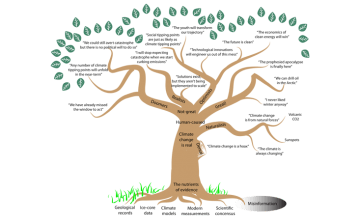Summer Pretorius in Nautilus:
 As a paleoclimatologist, I often find myself wondering why more people aren’t listening to the warnings, the data, the messages of climate woes—it’s not just a storm on the horizon, it’s here, knocking on the front door. In fact, it’s not even the front door anymore. You are on the roof, waiting for a helicopter to rescue you from your submerged house. The data is clear: The rates of current carbon dioxide release are 10 times greater than even the most rapid natural carbon catastrophe1 in the geological records, which brought about a miserable hothouse world of acidic oceans lacking oxygen, triggering a pulse of extinctions.2 Despite the evidence for anthropogenic climate change, views about the severity and impact of global warming diverge like branch points on a gnarly old oak tree (below).
As a paleoclimatologist, I often find myself wondering why more people aren’t listening to the warnings, the data, the messages of climate woes—it’s not just a storm on the horizon, it’s here, knocking on the front door. In fact, it’s not even the front door anymore. You are on the roof, waiting for a helicopter to rescue you from your submerged house. The data is clear: The rates of current carbon dioxide release are 10 times greater than even the most rapid natural carbon catastrophe1 in the geological records, which brought about a miserable hothouse world of acidic oceans lacking oxygen, triggering a pulse of extinctions.2 Despite the evidence for anthropogenic climate change, views about the severity and impact of global warming diverge like branch points on a gnarly old oak tree (below).
The first split is between deniers and acceptors; only the denial branch doesn’t go anywhere—it’s just a dead stump, no longer sustained by the nutrients of evidence. The next bifurcation is on the root cause of climate change. Naturalists say “the climate has always changed,” which aside from ignoring evidence that the recent increase in carbon dioxide is from burning fossil fuels,3 is a diversion tactic for derailing meaningful conversations by stating the obvious. Of course, the climate is always changing; the relevant variable is the rate at which it does so.
If we follow the branch line that accepts the evidence for human-induced climate change, the next major split is between those who see global warming as a good thing and those who view it as a bad one. The former view an ice-free Arctic as a business boon for oil extraction or sweltering cities as an expanding market for air conditioners, or they are your clueless uncle joking about his property going up in value because it will suddenly be beachfront property.
More here.
